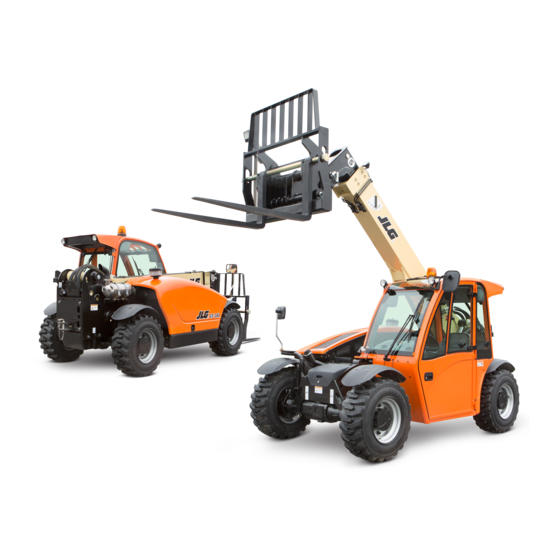
Table of Contents
Advertisement
Quick Links
Advertisement
Table of Contents

Summarization of Contents
Read This First
Operator Qualifications
Essential operator requirements for safe machine operation.
Other Publications Available
Lists related JLG manuals for further reference.
Section 1 - General Safety Practices
1.1 Hazard Classification System
Defines hazard symbols and signal words for safety alerts.
1.2 General Precautions
Important general safety advice and warnings for all operators.
1.3 Operation Safety
Detailed safety procedures and hazards during machine operation.
Electrical Hazards
Safety guidelines and minimum approach distances for electrical hazards.
Tip Over Hazard
Precautions to prevent machine tip-over during operation and load handling.
Travel Hazard
Safety considerations and best practices for machine travel and steering.
Pinch Points and Crush Hazards
Warnings about hazardous pinch points and crush risks.
Chemical Hazards
Safety precautions related to exhaust fumes, flammable fuel, and hydraulic fluid.
1.4 Clearsky (If Equipped)
FCC information for users regarding radio frequency interference.
Section 2 - Pre-Operation and Inspection
2.1 Pre-Operation Check and Inspection
Comprehensive checklist for daily pre-operation inspection of the machine.
2.2 Safety Decals
Ensures all safety decals, warnings, and capacity charts are visible and legible.
2.3 Walk-Around Inspection
Detailed procedure for performing a thorough walk-around inspection of the machine.
2.4 Warm-Up and Operational Checks
Steps for warming up the engine and checking all machine functions.
2.5 Operator Cab
Safety considerations and maintenance for the operator's cab and structure.
Section 3 - Controls and Indicators
3.1 General
Overview of control functions covered in this section.
3.2 Controls
Identification and function of all machine controls and indicators.
Park Brake
Operation of park brake switch (G5-18A) and lever (2505H).
Transmission Control Lever
How to engage forward, reverse, and neutral travel modes.
Load Stability Indicator - LSI (2505H)
Functionality and operation of the LSI for stability monitoring.
Joystick
Operation of the joystick for boom, tilt, and auxiliary hydraulic functions.
Right Hand Console
Functions of switches and controls located on the right-hand console.
3.3 Steer Modes
Explanation of available steering modes and how to change them.
3.4 Operator Seat
Features and operation of the operator seat presence switch.
Seat Belt
Proper procedure for fastening and releasing the seat belt.
3.5 Boom Angle and Extension Indicators
Location and use of indicators for boom angle and extension.
Section 4 - Operation
4.1 Engine
Procedures for starting, operating, and shutting down the engine.
Starting the Engine
Step-by-step guide for safely starting the machine's engine.
Shut-Down Procedure
Correct steps for safely shutting down the machine after operation.
4.2 Operating with a Non-Suspended Load
Safe practices for lifting, transporting, and placing non-suspended loads.
Before Picking Up a Load
Preparation steps and checks before lifting a load.
Leveling Procedure
Steps to ensure the machine is level before lifting or placing loads.
4.3 Operating with a Suspended Load (ANSI & CE)
Safety guidelines for operating with suspended loads.
Transporting a Suspended Load
Safe practices for moving suspended loads.
4.4 Road Operation (2505H)
Steps for preparing and operating the telehandler on public roads.
4.5 Loading and Securing for Transport
Procedures for safely loading and securing the telehandler for transport.
Section 5 - Attachments and Hitches
5.1 Approved Attachments
Criteria for determining if an attachment is approved for use.
5.4 Telehandler/Attachment/Fork Capacity
How to determine the maximum lifting capacity of the telehandler and attachment.
5.5 Use of the Capacity Chart
Guide on how to correctly interpret and use capacity charts.
5.6 Attachment Installation
Procedures for installing standard and quick attach systems.
Standard Quick Attach
Steps for mechanically attaching and detaching standard quick attach systems.
Hydraulic Quick Attach
Procedure for one-person installation of hydraulic quick attaches.
5.8 Adjusting/Moving Forks
Methods for repositioning or removing forks from the carriage.
5.10 Hitches
Information on various hitch types and their towing capacities.
Adjustable Auto Hitch
Connecting and adjusting adjustable auto hitches for towing.
Section 6 - Emergency Procedures
6.1 Towing a Disabled Product
Procedures for moving a telehandler that cannot be powered.
6.2 Emergency Lowering of Boom
Procedures for safely lowering the boom in power failure situations.
6.3 Emergency Exit from Enclosed Cab
Methods for exiting the cab in an emergency.
Section 7 - Lubrication and Maintenance
7.2 General Maintenance Instructions
General guidelines and precautions before performing service or maintenance.
7.3 Service and Maintenance Schedule
Schedules for routine maintenance tasks at various hour intervals.
7.5 Operator Maintenance Instructions
Daily and periodic maintenance tasks for the operator.
Fuel System
Procedures for checking fuel level and draining the fuel/water separator.
Engine Oil
Steps for checking and maintaining the engine oil level.
Hydraulic Oil
Procedure for checking and maintaining the hydraulic oil level.
Tires
Checks for tire air pressure, damage, and replacement guidelines.
Section 8 - Additional Checks
8.2 Load Stability Indicator System (2505H)
Test procedure to verify the functionality of the LSI system.
8.3 Reverse Sensing System (if equipped)
Procedure for testing the reverse sensing system's object detection.
Section 9 - Specifications
9.1 Product Specifications
Detailed specifications for machine fluids, capacities, and performance.
Fluids
Lists recommended fluids, viscosities, and temperature ranges for various systems.
Capacities
Specifies fluid capacities for engine, fuel tank, hydraulic, brake, and axles.
Performance
Key performance metrics including lift capacity, height, reach, and travel speed.
Machine Towing Capacity
Specifies towing capacities for off-road and on-road conditions.













Need help?
Do you have a question about the 2505H and is the answer not in the manual?
Questions and answers